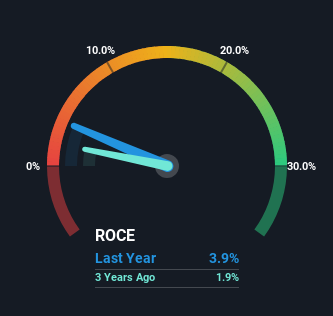Be Wary Of Pasupati Acrylon (NSE:PASUPTAC) And Its Returns On Capital
What are the early trends we should look for to identify a stock that could multiply in value over the long term? Ideally, a business will show two trends; firstly a growing return on capital employed (ROCE) and secondly, an increasing amount of capital employed. Basically this means that a company has profitable initiatives that it can continue to reinvest in, which is a trait of a compounding machine. In light of that, when we looked at Pasupati Acrylon (NSE:PASUPTAC) and its ROCE trend, we weren't exactly thrilled.
What Is Return On Capital Employed (ROCE)?
For those that aren't sure what ROCE is, it measures the amount of pre-tax profits a company can generate from the capital employed in its business. To calculate this metric for Pasupati Acrylon, this is the formula:
Return on Capital Employed = Earnings Before Interest and Tax (EBIT) ÷ (Total Assets - Current Liabilities)
0.039 = ₹122m ÷ (₹3.5b - ₹398m) (Based on the trailing twelve months to September 2023).
So, Pasupati Acrylon has an ROCE of 3.9%. Ultimately, that's a low return and it under-performs the Luxury industry average of 10%.
See our latest analysis for Pasupati Acrylon

Historical performance is a great place to start when researching a stock so above you can see the gauge for Pasupati Acrylon's ROCE against it's prior returns. If you'd like to look at how Pasupati Acrylon has performed in the past in other metrics, you can view this free graph of past earnings, revenue and cash flow.
The Trend Of ROCE
On the surface, the trend of ROCE at Pasupati Acrylon doesn't inspire confidence. To be more specific, ROCE has fallen from 39% over the last five years. And considering revenue has dropped while employing more capital, we'd be cautious. This could mean that the business is losing its competitive advantage or market share, because while more money is being put into ventures, it's actually producing a lower return - "less bang for their buck" per se.
On a side note, Pasupati Acrylon has done well to pay down its current liabilities to 11% of total assets. That could partly explain why the ROCE has dropped. What's more, this can reduce some aspects of risk to the business because now the company's suppliers or short-term creditors are funding less of its operations. Some would claim this reduces the business' efficiency at generating ROCE since it is now funding more of the operations with its own money.
The Bottom Line On Pasupati Acrylon's ROCE
We're a bit apprehensive about Pasupati Acrylon because despite more capital being deployed in the business, returns on that capital and sales have both fallen. However the stock has delivered a 23% return to shareholders over the last year, so investors might be expecting the trends to turn around. Regardless, we don't feel too comfortable with the fundamentals so we'd be steering clear of this stock for now.
If you want to continue researching Pasupati Acrylon, you might be interested to know about the 2 warning signs that our analysis has discovered.
For those who like to invest in solid companies, check out this free list of companies with solid balance sheets and high returns on equity.
New: Manage All Your Stock Portfolios in One Place
We've created the ultimate portfolio companion for stock investors, and it's free.
• Connect an unlimited number of Portfolios and see your total in one currency
• Be alerted to new Warning Signs or Risks via email or mobile
• Track the Fair Value of your stocks
Have feedback on this article? Concerned about the content? Get in touch with us directly. Alternatively, email editorial-team (at) simplywallst.com.
This article by Simply Wall St is general in nature. We provide commentary based on historical data and analyst forecasts only using an unbiased methodology and our articles are not intended to be financial advice. It does not constitute a recommendation to buy or sell any stock, and does not take account of your objectives, or your financial situation. We aim to bring you long-term focused analysis driven by fundamental data. Note that our analysis may not factor in the latest price-sensitive company announcements or qualitative material. Simply Wall St has no position in any stocks mentioned.
About NSEI:PASUPTAC
Pasupati Acrylon
Manufactures and sells acrylic fibers, cast polypropylene (CPP) films in India.
Adequate balance sheet with acceptable track record.
Market Insights
Community Narratives



